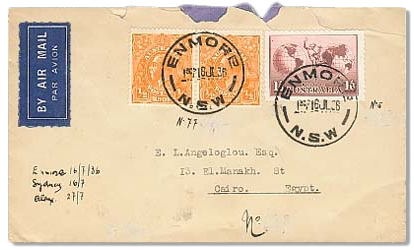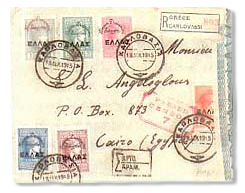The cover has a total postage of 1/ 7d made up of a pair of ½d orange KGV heads and the 1/6 Hermes airmail stamp. It has two ENMORE/ 130P 16 JL 36/ N.S.W postmarks plus a blue By Air Mail/ Par Avion vignette. It is addressed to E. L. Angeloglou. Esq./ 13. El. Manakh. St/ Cairo, Egypt. The dates at Enmore, Sydney and Alexandria are written in ink manuscript, on the front (Figure 1 right).

The reverse is postmarked SYDNEY/ 4P 16 JY 36/ 32, with a RECU PAR/ AVION/ ALEXANDRIA/ 27 JL 36 8 45P transit mark and a reception mark of CAIRO/ 28 JLY/ 1936/ 7 AM. Both the Egyptian postmarks have additional arabic inscriptions (Figure 2 below).
Information about the addressee was limited, but of considerable philatelic interest. He authenticated Hejaz stamps in red script with ‘ela’, and there is both an authentic mark, which occurs in either red or blue, as well as a fake version of this marking (Figure 3 below).
A description of 3 additional Angeloglou covers was found in auction catalogues, but only one of these was pictured. This was a registered cover from Carlovassi, Greece dated 1915 and sent to him at P.O. Box 873, Cairo Egypt, his surname now having an added ‘s’ (Figure 4 below).
An advertisement in the ‘Die Post Leipzig’ dated February 1905 was placed by E.L. Angeloglous at the same Post Office Box 873 in Cairo (Figure 5 below).
Only three small pieces of additional information on the internet have been found subsequently: Angeloglou was born in 1878, his authentication of Hejaz stamps was reported to be more reliable than on Nejd issues, and his expertation mark of ‘ela’ was used up to 1943. With this paucity of data on the internet I thought that the research on my cover had come to a halt.
I was able to contact Dr. Peter A. S. Smith a retired academic living in Ann Arbor, Michigan who is the leading authority on Egypt. His book Egypt – Stamps and Postal History took almost 65 years to research and write, and is a massive volume of 922 pages. He most graciously provided the following information on Angeloglou, which is quoted almost verbatim, as a summary of three emails:
“I am now 84 and that age puts me close to contemporaneity with Angeloglou, although I never met him. A Greek name is not unusual in Egypt – there are lots of Egyptian-born Greeks, but fewer since the 1952 revolution (leading to the abdication of King Farouk). Angeloglou was one of the old-time dealers who was a scholar, who loved stamps, willingly helped researchers, and had a deep knowledge. He was the dean of Egyptian dealers, and was not surpassed before nor since. His clientele was mostly European, although it included the most prominent Egyptians as well”.
“His stock was said to be enormous, and included much in sheets, varieties valuable and obscure, just the sort of stock that one would have loved to be able to browse through. In the earlier issues of L’Orient Philatelique (the Journal of the Egyptian Philatelic Society), he was often cited. I believe he started business in the 1920’s, but it may have been earlier (Figure 5 proves he was in business as early as 1905). The earliest advertisement (for him) I can locate is in 1929 when he took out a full page ad on the back cover of L’Orient Philatelique (he was evidently well established at that time)”.
“His address at that time was 13 Sharia El Mankh (the address on my cover in 1936). By 1940 it became 44 Sharia Malika Farida, and it changed to 44 Sharia Abdel Khalek Sarwat by 1949 (the name was changed when King Farouk divorced Queen Farida). By April 1952 his address was 26 Sharia Sherif Pasha, which address continued until the last ad in January 1958.”
“All these places are a few blocks off Shepheard’s Hotel and even closer to the Continental Hotel. I hope that this information is what you wanted. I wish I could provide more.”
Addendum on Shepheard’s Hotel, Cairo: The original hotel, built in 1841 by Samuel Shepheard for British passengers on their way to India and the Far East, was located near Opera Square, away from the River Nile. For a great number of years it was the social mecca of British Army Officers. One can image that many of his European clientele would have stayed at this hotel. It was burnt down in the civil unrest of 1952 when much of “British Cairo” was destroyed. The hotel’s opulence is shown in Figure 6 (above).












Hello,
I really believe that the “ela” signature on the stamps are mine. When I was a young boy, I lived in Cairo, Egypt. My nick name then was Ela. My father was a stamp collector. When I was about 10 years old, I decided to start collecting stamps, like my father. I “stole” some of my father’s stamps and claimed them by signing my name on the back. When my father found out, he was very upset. He told me that I ruined the stamps and that afternoon, he whipped me with his belt. I cannot forget that day. I am convinced that the signature is mine, although, I cannot prove it.
Samuel Ela Sidhom
Dear Samuel,
Many thanks for your comment. It’s always interesting to hear of such philatelic relationships. Surely this is one of the many joys of postal history.
Do you have any images of either your father or his shop? We would love to hear of any personal reminiscences too.
I hope this finds you well!
Warmest regards,
William
There are also a forged ela,where the loop of l is bigger.
It’s impressive that you are getting thoughts from this piece of writing as well as from our argument made here.
My website – Gwendolyn
Hey terrific blog! Does running a blog such as this require a large amount of work?
I have very little expertise in computer programming
however I was hoping to start my own blog in the
near future. Anyway, should you have any suggestions or tips
for new blog owners please share. I know this is off topic but I simply wanted to ask.
Thank you!
my web page … vichy laboratories proeven total dark spot corrector
Hello,
I am E. L. Angeloglou grandson and I read your article with a great interest.
I loved my grandfather and I still have some documents about him and his collection.
I would be extremely happy to be in contact and exchange with Maurice Mishkel and Dr. Peter A. S. Smith. Would it be possible to receive their e-mail?
Thank you very much,
Denys Angeloglou